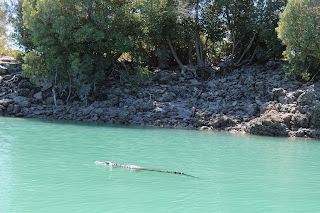For today's run, we drove the short distance to Minyirr Conservation Park - a narrow strip of coastal dunes behind the famous Cable Beach. We were hoping for a loop within the dunes, however it turns out there is really only one track through the middle with several tracks crossing it to provide access to Cable Beach. so we ended up on the beach fairly quickly. No problem, we joined the early morning beach goers and continued along the beach before taking our chance on a trail back into the dunes. It was an easy although sandy run back to the car.






By the time we leave around 2pm, the tide was on its way in. Those on the afternoon tour were only required to descend 10 steps to board the boat and the small lagoon adjacent the boat steps was filling fast. The tides in this area are unbelievable as seen in the photos below - a 3 hour time difference between the two photos.
Our activity today was a trip to Willie Creek Pearl Farm. We opted for the self drive confident that the 4WD car we had hired could do the job. Located 45km from Broome, most of the drive was on dirt. We were a little worried when at the turn off to Willie Creek, there were many vehicles exiting and reinflating their tyres. Our car was not that sort of 4WD. Anyway we pushed on. In a couple of sections, the road in was the worst we'd experienced on our trip with deep corrugations and soft sand. We were pleased to roll into the Willie Creek carpark.
For the next few hours we had the full pearl experience - history of pearling, intricacies of commercial pearl farming to harvesting and construction of jewellery.
We began in the hatchery - where oysters, the actual shell, are created and grown. Once big enough, oyster shells are transferred into their own pocket on a panel and taken our to sea to be placed on a long line. Over the next two years, the oysters continue to grow in the warm tidal turquoise waters. The pearl farmers visit the oysters around every 6 weeks to clean the seaweed and barnacles which also love to flourish in these waters.
By the time the oyster is 2 years old, they return to the harvest shed for virgin seeding. You see a pearl is made when a piece of sand or other irritant is trapped within the oyster shell. The oyster produces nacre, a sticky substance which coats the intruder and prevents further injury.
The chance of creating a natural pearl in the wild in 1:5000, so with cultivated pearls, the seed is a round piece of mussel shell. The pearl produces nacre to heal itself and in the process coats the intruder. The oyster is placed back into a pocket of the panel and taken out to sea for the pearl to grow. As the tides flips the panel around, the foreign body of the mussel shell is coated all over in nacre - hopefully evenly.
The pearl farmers keep an eye on the oyster shells looking for pests and disease that may appear as well as cleaning off the seaweed and barnacles. After another 2 years of growing, the pearls are ready to harvest.
We made our way from the harvest shed, to the boat. It was low tide as we motor away from the jetty. Our tour guide pointed out that the 19 steps we descended to get to the boat would completely disappear on the higher tides. A short distant from the jetty, one of the female saltwater crocodile makes an appearance floating on the water's surface. She seems unconcerned by our presence. There are 3 resident salt water crocodiles in Willie Creek - 2 girls and a boy.
In the middle of the creek is a long line. Our tour guide pulls up one of the panels and talks more about the farming process. After returning the panel into the water, we continue upstream for a few minutes. Several Aborigines are out fishing on the banks and at a rock ledge known as Flat Rock.
Back on land, we converge on the deck for morning tea. Homemade damper, fruit and drinks refresh us. Our tour concludes with the Pearl Masterclass. Here we learn about the oysters anatomy and harvest a pearl! We learn about the five qualities pearls are rated on - size, shape, colour, lustre and complexion. Our harvested pearl has several black blemishes and is deemed substandard and therefore would not be sold. Willie Creek has very high standards for the selection of their pearls. Apparently a month ago at a harvesting tour like ours, the pearl that came out was the biggest they had ever seen - a whopping 20mm and valued somewhere over $100,000!






Once the pearl has been removed during the harvesting, it is replaced with another mussel shell seed which is the same size as the pearl that came out. The oyster is returned to the sea for a new pearl to grow. Most oysters are able to have this process repeated 3- 5 times.
From the Masterclass, we are ushered into the showroom to learn about the final product, the jewellery. We note that salt water pearls are expensive due to the time taken to grow a pearl and the unpredictability of the quality. Their cousins the freshwater pearls are much cheaper as they are easier to grow.
At the conclusion of our tour, we make our way back onto the deck for lunch. Andy ordered a From the Land platter, while I chose the From the Sea (which included a tiny taste of pearl meat ($200/kg) and the kids were much less adventurous with nuggets and chips! It was an nice relaxing lunch with views of the stunning colours of Willie Creek. We reminiscing about how interesting the tour was.












No comments:
Post a Comment